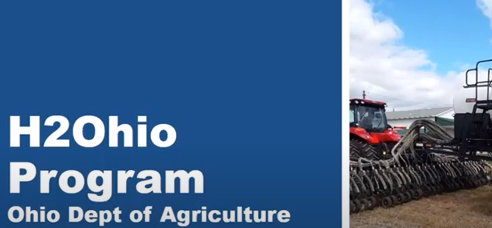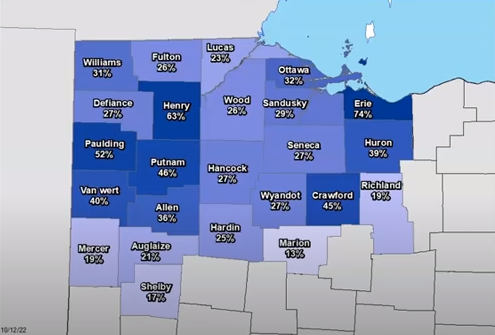By MEGAN SUTHERLAND
BG Independent News
It’s been one year since the H2Ohio Water Quality Program was rolled out from the Ohio legislature and into the farm fields of Northwest Ohio, and the response has been “overwhelming” according to H2Ohio Program Director, Terry Mescher.
Mescher presented the Center for Innovative Food Technology’s October Agribusiness Forum and its last forum of 2022, discussing the agricultural portion of the H2Ohio program and updates on its first year in operation.
The state-wide program, initiated in 2019 by Governor Mike DeWine, addresses several water quality issues in the state, with one important issue being the consistently high nutrient levels of Ohio’s waterways. High levels of phosphorus and nitrogen have caused numerous and dangerous agal blooms in Lake Erie, the most memorable being the water crisis of 2014.

The agricultural area of the program is managed as a collaborative effort of the Ohio EPA, Dept of Natural Resources, and Dept of Agriculture, and aims to accomplish its goals by focusing on three areas-Nutrient Management, Erosion, and Water Management.
Its goal is to reduce the overall phosphorus load entering Lake Erie from the Maumee and western Lake Erie basin by 40 percent, using 2008 levels as a baseline. If this amount, which equates to an 800,000-pound reduction, is reached, it is believed that the agal blooms in Lake Erie will eventually be made insignificant for nine out of every ten years. And towards this effort, Ohio is investing a yearly operating budget of around $85 million.
“It is really an incredible effort,” Mescher says. “I am not aware of any conservation effort that is state-funded that rivals what Ohio is trying to do on the water quality front.”
Mescher and his team work with farmers from 24 counties in Northwest Ohio to create and implement a Volunteer Nutrient Management Plan. To do this they evaluate the nutrient and erosion management realities and possibilities for each field to create a plan that will reduce the most nutrient loss possible without any sacrifice to yields. If farmers participate and meet the plan’s guidelines, they are given incentive payments.
In nutrient management, soil testing is used to ensure farm fields are not fertilized above capacity and evaluate how and when fertilizer is applied. This can include avoiding fertilizer applications that will enter the lake during peak agal bloom season as well as application methods, such as mixing in manure instead of an on-top application and injecting commercial fertilizers directly into farm soil.
Erosion management encourages planting cover crops in winter to aid in the field’s nutrient retention and using conservation crop rotation to remediate soil.
And farmers are responding, with an average of 32 percent of farmland in the program area, equaling 1.6 million acres, participating in a voluntary nutrient management program and/or erosion prevention.
Wood County currently sits a little below that average with 26 percent of all farmland acreage in participation.

“To say that interest has exceeded expectations is an understatement,” Mescher says. “The overall interest in the program has been fantastic.”
It has exceeded expectations so much, in fact, that the ODA has had difficulty keeping up. With a total of 40 employees and limited software and technology resources, “We haven’t had the capacity within the Soil and Water District to match up and keep up with demand to be perfectly honest,” Mescher says.
“That’s one of our failings at the ODA – not anticipating the interest and not understanding the workload that we were creating when we rolled out this program.”
In its first year on the scene, the H2Ohio program has had great success in finding engaged partners in local agricultural producers, as well as clear areas in which to improve and deliver their services.
Growing too much and too quickly is a serious and long-term problem when it comes to agal blooms, but thankfully not for programs. That type of engagement, supported and sustained, may be exactly what is needed to make positive change in Ohio’s waterways.
To learn more about H2Ohio or how to participate, more information can be found at https://h2.ohio.gov/.





